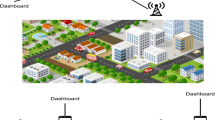Abstract
The innovations in the interconnectivity of vehicles enable both expediency and insecurity. Surely, the convenience of gathering real-time information on traffic and weather conditions, the vehicle maintenance status, and the prevailing condition of the transport system at a macro level for infrastructure planning purposes is a boon to society. However, this newly found conveniences present unintended consequences. Specifically, the advancements on automation and connectivity are outpacing the developments in security and safety. We simply cannot afford to make the same mistakes similar to those that are prevalent in our critical infrastructures. Starting at the lowest level, numerous vulnerabilities have been identified in the internal communication network of vehicles. This study is a contribution towards the broad effort of securing the communication network of vehicles through the use of Machine Learning.
Access this chapter
Tax calculation will be finalised at checkout
Purchases are for personal use only
Similar content being viewed by others
References
Karahasanovic A (2016) Automotive cyber security. Chalmers University of Technology, Gotehnburg, Sweden
Gemalto (2018) Securing vehicle to everything [Online]. Available: https://www.gemalto.com/brochures-site/download-site/Documents/auto-V2X.pdf. Accessed 13 April 2020
Francia GA (2020) Connected Vehicle Security. In: 15th international conference on cyber warfare and security (ICCWS 2020), Norfolk
Torre GD, Rad P, Choo KR (2020) Driverless vehicle security: challenges and future research opportunities. Future Gener Comput Syst 108:1092–1111
Devir N (2019) Applying machine learning for identifying attacks at run-time [Online]. Available: https://www.cs.technion.ac.il/users/wwwb/cgi-bin/tr-get.cgi/2019/MSC/MSC-2019-06.pdf. Accessed 13 April 2020
Avatefipour O, Al-Sumaiti AS, El-Sherbeeny AM, Awwad EM, Elmeligy MA, Mohamed MA, Malik H (2019) An intelligent secured framework for cyberattack detection in electric vehicles’ CAN bus using machine learning. IEEE Access 7:127580–127592. https://doi.org/10.1109/ACCESS.2019.2937576
Vasistha DK (August 2017) Detecting anomalies in controller area network (CAN) for automobiles [Online]. Available: https://cesg.tamu.edu/wp-content/uploads/2012/01/VASISTHA-THESIS-2017.pdf. Accessed 13 April 2020
Zhou A, Li Z, Shen Y (2019) Anomaly detection of CAN bus messages using a deep neural network for autonomous vehicles. Appl Sci 9:3174
Lokman S, Othman AT, Abu-Bakar M (2019) Intrusion detection system for automotive controller area network (CAN) bus system: a review. J Wireless Com Network 184 https://doi.org/10.1186/s13638-019-1484-3
Kang MJ, Kang JW (2016) Intrusion detection system using deep neural network for in-vehicle network security. PLoS One 11(6)
Taylor A, LeBlanc S, Japkowiz N (2016) Anomaly detection in automobile control network data with long short-term memory networks. In: 2016 international conference on data science and advanced analytics (DSAA), Montreal
Wasicek A, Weimerskirch (2015) Recognizing manipulated electronic control units. SAE
Jaynes M, Dantu R, Varriale R, Evans N (2016) Automating ECU identification for vehicle security. In: 2016 15th IEEE international conference on machine learning and applications (ICMLA), Anaheim, CA
Kumar S, Singh K, Kumar S, Kaiwartya O, Cao Y, Zhao H (2019) Delimitated anti jammer scheme for internet of vehicle: machine learning based security approach. IEEE Access 7:113311–113323
Corrigan S (2016) Introduction to the controller area network (CAN). Texas Instruments, Dallas, TX
Maggi F (2017) A vulnerability in modern automotive standards and how we exploited it. Trend Micro
Bishop CM (2007) Patern recognition and machine learning. Springer, Belrin
Kim J, Francia G (2018) A comparative study of neural network training algorithms for the intelligent security monitoring of industrial control systems. In: Computer and network security essentials. Springer International Publishing AG, pp 521–538
De Boer P, Kroese DK, Mannor S, Rubinstein RY (2005) A tutorial on the cross-entropy method. Ann Oper Res 134:19–67
McCaffrey J (2014) Neural network cross entropy error. Vis Studio Mag 04:11
Marquardt D (1963) An algorithm for least-squares estimation of nonlinear parameters. SIAM J Appl Math 11(2):431–441
Dennis JE, Schnabel RB (1983) Numerical methods for unconstrained optimization and nonlinear equations. Prentice-Hall, Englewoods Cliffs, NJ
Riedmiller M, Braun H (1993) A direct adaptive method for faster backpropagation learning: the RPROP algorithm. In: Proceedings of the IEEE international conference on neural networks
Moller M (1993) A scaled conjugate gradient algorithm for fast supervised learning. Neural Netw 6:525–533
Hagan MT, Demuth HB, Beale MH (1996) Neural network design. PWS Publishing, Boston
Scales L (1985) Introduction to non-linear optimization. Springer-Verlag, New York
Magnus JR, Neudecker H (1999) Matrix differential calculus. John Wiley & Sons Ltd., Chichester
Han ML, Kwak BI, Kim HK (2018) Anomaly intrusion detection method for vehicular networks based on survival analysis. Veh Commun 14:52–63
Crow D, Graham S, Borghetti B (2020) Fingerprinting vehicles with CAN Bus data samples. In: Proceedings of the 15th international conference on cyber warfare and security (ICCWS 2020), Norfolk, VA
Weinberg GM (5 Feb 2017) Fuzz testing and fuzz history [Online]. Available: https://secretsofconsulting.blogspot.com/2017/02/fuzz-testing-and-fuzz-history.html. Accessed 6 April 2020
Stone B, Graham S, Mullins B, Kabban C (2018) Enabling auditing and intrusion detection for proprietary controller area networks. Ph.D. Dissertation, Air Force Institute of Technology, Dayton, OH
Acknowledgements
This work is partially supported by the Florida Center for Cybersecurity, under grant # 3901-1009-00-A (2019 Collaborative SEED Program) and the National Security Agency under Grant Number H98230-19-1-0333. The United States Government is authorized to reproduce and distribute reprints notwithstanding any copyright notation herein.
Author information
Authors and Affiliations
Corresponding author
Editor information
Editors and Affiliations
Rights and permissions
Copyright information
© 2021 The Editor(s) (if applicable) and The Author(s), under exclusive license to Springer Nature Switzerland AG
About this chapter
Cite this chapter
Francia, G.A., El-Sheikh, E. (2021). Applied Machine Learning to Vehicle Security. In: Maleh, Y., Shojafar, M., Alazab, M., Baddi, Y. (eds) Machine Intelligence and Big Data Analytics for Cybersecurity Applications. Studies in Computational Intelligence, vol 919. Springer, Cham. https://doi.org/10.1007/978-3-030-57024-8_19
Download citation
DOI: https://doi.org/10.1007/978-3-030-57024-8_19
Published:
Publisher Name: Springer, Cham
Print ISBN: 978-3-030-57023-1
Online ISBN: 978-3-030-57024-8
eBook Packages: Intelligent Technologies and RoboticsIntelligent Technologies and Robotics (R0)




